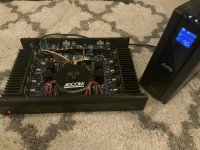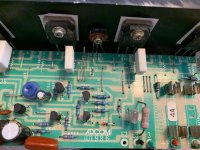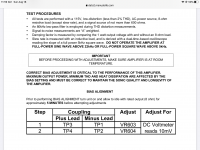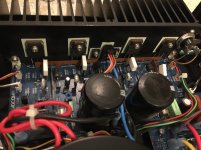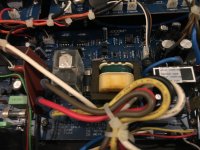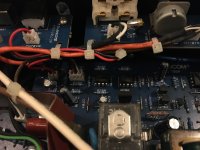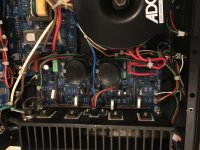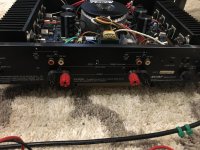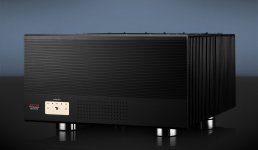First off ***WARNING*** this is an experiment/for personal enjoyment and could be wrong and dumb, please don't do it.
I took this perfectly workable amp, and purposely upped the bias slowly by 1watt increments alternating left/right channel until I got to 90watts* (45watts a channel classA vs 6), up from 12watts out the wall factory.
Stopped increasing when the heatsinks hit 55degC idle and stable, heat was my limiter--> increase from fairly cold idle.
Why? Because this amp is an old backup, sounds kinda meh and I've been exposed to new amps and how they sound vs my classD.
Anyway this changed the sound, now has sweet dense tone, opened it way up, complex resolved transients and is fun to listen to. It does not sound like added distortion** or anything like that.
Is it just super warmed up, or more ClassA operation?! dunno YMMV
Could have dreamt it but, always thought about doing this because somewhere I swear Nelson Pass said why not crank the bias until the heatsinks are hot on his smaller Adcoms for more classA operation.
DC offset is still 14mV, 20mV -- that didn't really change. They both shift around +/- 3mV
Also I don't know the test point to properly bias it to factory, maybe someone has a snippet on how to do that on the 5002?
*by watching the power draw from the wall
**read you can check this by running a sine wave in and check the output sine for clipping, I am lazy and did not do this.
System: YggdrasilA2(UNISON/digionesig)-->Jenson 1:1 bal/se-->freya passive-->GFA5002-->Elac adante/debut 6.2 / MLdescent i x2
Thanks!!
I took this perfectly workable amp, and purposely upped the bias slowly by 1watt increments alternating left/right channel until I got to 90watts* (45watts a channel classA vs 6), up from 12watts out the wall factory.
Stopped increasing when the heatsinks hit 55degC idle and stable, heat was my limiter--> increase from fairly cold idle.
Why? Because this amp is an old backup, sounds kinda meh and I've been exposed to new amps and how they sound vs my classD.
Anyway this changed the sound, now has sweet dense tone, opened it way up, complex resolved transients and is fun to listen to. It does not sound like added distortion** or anything like that.
Is it just super warmed up, or more ClassA operation?! dunno YMMV
Could have dreamt it but, always thought about doing this because somewhere I swear Nelson Pass said why not crank the bias until the heatsinks are hot on his smaller Adcoms for more classA operation.
DC offset is still 14mV, 20mV -- that didn't really change. They both shift around +/- 3mV
Also I don't know the test point to properly bias it to factory, maybe someone has a snippet on how to do that on the 5002?
*by watching the power draw from the wall
**read you can check this by running a sine wave in and check the output sine for clipping, I am lazy and did not do this.
System: YggdrasilA2(UNISON/digionesig)-->Jenson 1:1 bal/se-->freya passive-->GFA5002-->Elac adante/debut 6.2 / MLdescent i x2
Thanks!!
Attachments
Last edited:
The GFA-5002 looks to be an updated home theater version of the GFA-535 with a bit less power but some added HT features. These little amps sound pretty good as long as you don’t ask them to drive difficult speaker loads at insane volumes. I’ve attached the factory bias instructions as well as a picture of a GFA535 showing the test points. If your amp doesn’t have test points you would connect your meter to one of the emitter resistors instead.
IMO there is little if anything besides heat to be gained by cranking up the bias on these Adcom amps with the BJT outputs.
IMO there is little if anything besides heat to be gained by cranking up the bias on these Adcom amps with the BJT outputs.
Attachments
IMO there is little if anything besides heat to be gained by cranking up the bias on these Adcom amps with the BJT outputs.
Of course it's worth the experiment. Historically I have seen examples of
BJT amplifiers that have higher measured thd at bias higher than "optimum",
but they often sounded better for it, even if it produces a bit of a hump in
the power vs distortion curves. Good example would be the Ayre power
amplifier.
Thanks!
Also looking around more do these Adcoms really use those JRC4558 opamps on the input stage (ugh)? Hoping maybe it's to support the auto-on audio sense circuit or drive the pre-out feature!
Also looking around more do these Adcoms really use those JRC4558 opamps on the input stage (ugh)? Hoping maybe it's to support the auto-on audio sense circuit or drive the pre-out feature!
Attachments
You will appreciate that companies do not inform me of additions and improvements
after they have paid for a design.
Probably think I'll send them another invoice.....
😉
after they have paid for a design.
Probably think I'll send them another invoice.....
😉
Of course it's worth the experiment. Historically I have seen examples of
BJT amplifiers that have higher measured thd at bias higher than "optimum",
but they often sounded better for it, even if it produces a bit of a hump in
the power vs distortion curves. Good example would be the Ayre power
amplifier.
Interesting-- Thank You!
You will appreciate that companies do not inform me of additions and improvements
after they have paid for a design.
Probably think I'll send them another invoice.....
😉
Too Funny!!!
I just looked to see if Adcom is in business, and there are?!
...Like the 5802 vibe on this beast... but c'mon, off center with the gold plate? 🙄
Attachments
Last edited:
These old Adcom amps are IMO some of the best deals available on the used market right now. The big 200w+ amps like the Gfa-555 are still a bit pricey but the smaller 100w amps like the 545 and 5400 are often available for around $150 in excellent condition.
No worries, that's just part of the protection circuit! Quite impressive, really. They are used to protect against DC offset on the input.
The preamp-out is simply tied in parallel to the input; no buffering.
The circuit is essentially identical to the old 535 MK1, though using a transistor-based biasing scheme instead of Nelson's thermistor-based setup. I don't really know if that's an improvement or not.
I like how they've moved the power supply caps onto the amplifier board itself! That tightens up the loops considerably. On the old 535, the star-ground is way back at the power supply board.
The preamp-out is simply tied in parallel to the input; no buffering.
The circuit is essentially identical to the old 535 MK1, though using a transistor-based biasing scheme instead of Nelson's thermistor-based setup. I don't really know if that's an improvement or not.
I like how they've moved the power supply caps onto the amplifier board itself! That tightens up the loops considerably. On the old 535, the star-ground is way back at the power supply board.
Thanks!
Also looking around more do these Adcoms really use those JRC4558 opamps on the input stage (ugh)? Hoping maybe it's to support the auto-on audio sense circuit or drive the pre-out feature!
I own the Mosfet based 5200 and 5300 and have increased the bias on both amps to get the heatsinks around 40 degrees.
Neither sound near as good as the M2X or Sissy SIT but they really hold their own regardless. Easily the best second hand bargains on the market .
I saw a 5400 for $115 a week or so ago and it took great will power not to pick it up but I knew it would merely sit on my shelf and hoped that someone who would actually use it would pick it up.
..dB
Neither sound near as good as the M2X or Sissy SIT but they really hold their own regardless. Easily the best second hand bargains on the market .
I saw a 5400 for $115 a week or so ago and it took great will power not to pick it up but I knew it would merely sit on my shelf and hoped that someone who would actually use it would pick it up.
..dB
Sorry, I'm wrong about that protection circuit!
The JRC4558 op-amps are definitely for the auto-on circuit. There is no input DC protection, just output protection provided by a UPC1237 chip.
First, the input is unity-gain buffered by one op-amp, then another op-amp boosts that signal by a gain of 122x, which is rectified to charge a capacitor that switches on the 555 timer, which has a time constant around 100 seconds. The remote trigger feeds into this same circuit.
The JRC4558 op-amps are definitely for the auto-on circuit. There is no input DC protection, just output protection provided by a UPC1237 chip.
First, the input is unity-gain buffered by one op-amp, then another op-amp boosts that signal by a gain of 122x, which is rectified to charge a capacitor that switches on the 555 timer, which has a time constant around 100 seconds. The remote trigger feeds into this same circuit.
Attached the schematic and service manual for reference.
Digging how it sounds, especially for late night listening-- very microdynamic with no hardness, and detail at low volume. Really temped to look around for a 2nd to monoblock them.
Cool, re: the 555 timer... saw that chip and figured it must be the timeout after there's no signal- for standby. (or something like that)
Again, I plan on light use only and keep it turned off, or enable the auto-standby mode. It's very hot while on-- Settled on about 50~55degC (direct on the heatsinks) pulling 80Watt from the wall idle.
Digging how it sounds, especially for late night listening-- very microdynamic with no hardness, and detail at low volume. Really temped to look around for a 2nd to monoblock them.
Cool, re: the 555 timer... saw that chip and figured it must be the timeout after there's no signal- for standby. (or something like that)
Again, I plan on light use only and keep it turned off, or enable the auto-standby mode. It's very hot while on-- Settled on about 50~55degC (direct on the heatsinks) pulling 80Watt from the wall idle.
Attachments
Last edited:
Hello Folks,
I hope my question is not out of place but I can't really find anything about this Amplifier anywhere else.
I got a GFA-5002 on eBay that was supposedly working but it wasn't so the seller offered me a reimbursement and in the end I ended up paying only shipping $30, so, long story short the amp doesn't do anything when I plug it to the power, I have tried all the switches, connected an input signal to it and still nothing, no lights or anything comes up.
I have checked all the fuses and the relays and they are all good, the AMP in general is in mint condition in and out so no components show any signs of damage, overheat, leakage, nothing...
Any suggestions what should I be checking first, before I start desoldering all the transistors?
Thanks in Advance!
I hope my question is not out of place but I can't really find anything about this Amplifier anywhere else.
I got a GFA-5002 on eBay that was supposedly working but it wasn't so the seller offered me a reimbursement and in the end I ended up paying only shipping $30, so, long story short the amp doesn't do anything when I plug it to the power, I have tried all the switches, connected an input signal to it and still nothing, no lights or anything comes up.
I have checked all the fuses and the relays and they are all good, the AMP in general is in mint condition in and out so no components show any signs of damage, overheat, leakage, nothing...
Any suggestions what should I be checking first, before I start desoldering all the transistors?
Thanks in Advance!
mains xformer is always next for checking
Thank You!
Just one more question I have, Is the on/standby LED supposed to come on red or green when its connected to the power?
Yes, yellow when rear switch set to off or auto. Red when on... it's never un-lit.
Gotcha, Thanks!!
Ok, so according to the schematic some voltage should be coming out from PT902 (stand-by transformer) and into D905 at all times, that voltage with the one from Q703 should be triggering the relay that would send voltage to the mains transformer, did I get that right?
If that's the case D905 doesn't have any voltage on it, well only 222 mV. I would expect much more than that...
OK, the Stand-By Transformer (PT902) is broken, all 4 wires on the secondaries are open and I tried to solder it but it had no success, it is plastic and with the heat it melted...
The original ADCOM part number is 24005002 (TT-345-U) any ideas where could I buy it?
The original ADCOM part number is 24005002 (TT-345-U) any ideas where could I buy it?
- Home
- Amplifiers
- Pass Labs
- Adcom GFA-5002 increase ClassA bias on purpose
